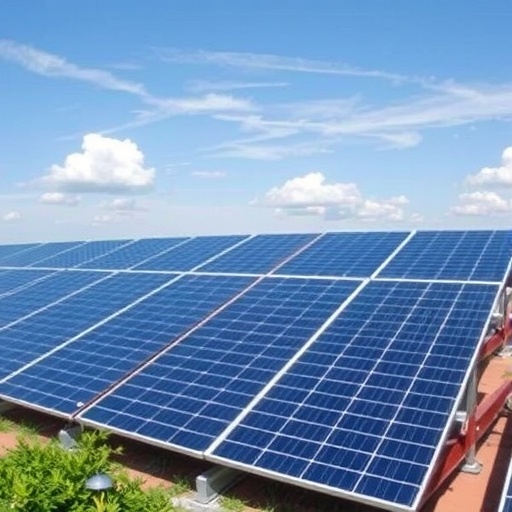In a world increasingly driven by the need for sustainable energy solutions, photovoltaic (PV) system design has become a focal point for researchers and engineers alike. A recent study conducted by a team led by Baranyai et al. investigates how different orientations and tilt angles of solar panels affect energy production, specifically within Hungary’s diverse climatic and geographical context. By examining regional variations and potential optimization methods, this research provides invaluable insights crucial for enhancing the efficiency of solar energy systems.
Solar energy, derived from the sun, is one of the most abundant and cleanest forms of energy available today. Its harnessing through PV systems has made significant strides, particularly as countries aim to transition away from fossil fuels. This study emphasizes the importance of optimizing solar panel placement to maximize energy output, which is particularly crucial in regions like Hungary that are committed to increasing their renewable energy share. Notably, the researchers delve into an analysis that combines geographical data with solar panel technology.
The orientation of solar panels refers to their positioning relative to the compass directions—south, east, west, and north. The tilt angle, on the other hand, is the angle of the panel with respect to the ground. The study finds that these two factors significantly influence the amount of solar energy captured throughout the year, which can vary widely based on local climatic conditions. By systematically evaluating these parameters, researchers aim to create guidelines that can be universally applied but tailored to local needs.
Throughout their study, Baranyai and colleagues utilized advanced simulation tools to model the energy production of various configurations of PV systems. By applying these models to numerous geographical regions within Hungary, they could analyze energy yield differences based on changes in tilt angle and orientation. Their results indicated distinct patterns that suggest a more localized approach to solar panel installation might yield enhanced efficiency.
Interestingly, the study also uncovers a regional disparity in solar energy production potential. Certain areas in Hungary were identified to have optimal conditions for energy generation due to their climatic factors and geographic characteristics. This finding highlights the need for localized strategies in PV installations rather than a one-size-fits-all approach. Understanding the regional nuances in solar energy production can not only increase the efficiency of existing solar farms but also guide future developments in solar technology.
The implications of optimizing orientation and tilt angles echo beyond Hungary. With a growing global focus on renewable energy, lessons learned from Hungary’s diverse landscapes can be transferred to other regions, creating a ripple effect in solar technology advancements. As nations strive for energy independence and sustainability, the integration of localized strategies into larger energy frameworks could serve as a significant step toward achieving these ambitious objectives.
In addition to energy yield, the research also examines the economic implications of optimizing PV systems. Initial investments in solar technology can be substantial, but optimizing design and location can reduce costs and improve the return on investment. This cost-to-benefit analysis creates a strong case for policymakers and stakeholders to support tailored solar projects. Such optimization strategies promise not only to enhance the overall energy landscape but also to stimulate local economies.
As energy demands continue to rise, improving the effectiveness of solar technology will play a crucial role in meeting future needs. The findings from Baranyai et al. underscore that even slight adjustments in panel orientation and tilt can lead to significant improvements in the amount of power generated. Therefore, decision-makers equipped with this knowledge will be better positioned to make informed investments in renewable energy infrastructure.
Furthermore, the study advocates for ongoing research into solar energy optimization techniques. As technological advancements persist, innovative methods for maximizing energy production will continue to emerge. Continued exploration of this field will not only benefit countries like Hungary but also contribute to the global fight against climate change by promoting clean energy solutions.
Collaboration between academia, industry, and government entities will be vital for advancing research and implementing effective strategies derived from studies like this one. The intersection of research and practical application can lead to breakthroughs that drive significant change in energy consumption patterns and pave the way for a more sustainable future. Moreover, fostering partnerships that focus on localized energy solutions can serve as a model for other countries seeking to enhance their renewable energy frameworks.
In conclusion, the research conducted by Baranyai and colleagues offers a comprehensive analysis of how orientation and tilt angles of PV systems impact energy production in Hungary. It emphasizes the importance of localized strategies and the integration of solar technology within broader energy policies. Insights garnered from this study can significantly contribute to the future of solar energy optimization, ultimately supporting global efforts towards a sustainable energy future.
As the world shifts towards renewable energy sources, understanding and employing the right strategies in solar power generation becomes imperative. Studies like this not only highlight the current state of solar technology but also illuminate pathways for future advancements, ensuring that we move toward a more energy-efficient world.
Subject of Research: The effect of orientation and tilt angle on PV system energy production in Hungary.
Article Title: The effect of orientation and tilt angle on PV system energy production in Hungary: regional comparison and optimization possibilities.
Article References:
Baranyai, N.H., Esses, N., Vincze, A. et al. The effect of orientation and tilt angle on PV system energy production in Hungary: regional comparison and optimization possibilities. Discov Sustain 6, 1192 (2025). https://doi.org/10.1007/s43621-025-02082-z
Image Credits: AI Generated
DOI: https://doi.org/10.1007/s43621-025-02082-z
Keywords: Renewable energy, photovoltaic systems, energy optimization, solar energy, tilt angles, geographic analysis.




